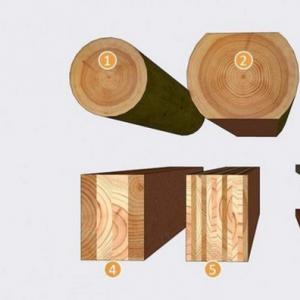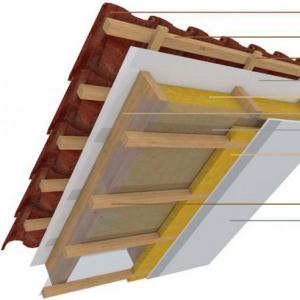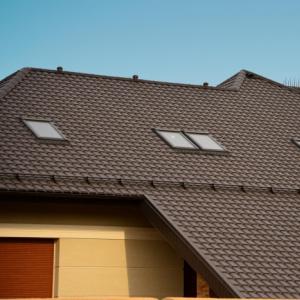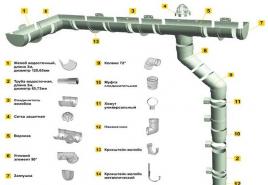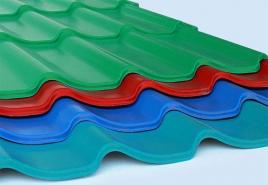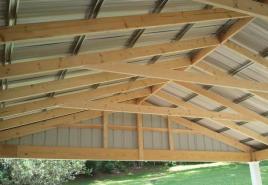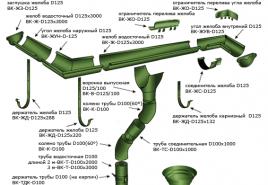Drainage and their varieties
Drain from the roof water is happening with the help of drains, which serve for structural protection of houses from the adverse effects of precipitation from the atmosphere. Thala and rainwater can contribute to the flooding of the foundation, the destruction of the scene, damage the appearance of the building. Plums for the roof are a system of gutters and pipes that are attached with couplings, connecting elements and other fasteners.
The drain from the roof, besides the lack of clusters of water near the house, make it possible to significantly extend the period of operation of the foundation of the building.
Plums for the roof, having a modern advanced option, are capable of not only to protect, but also decorate the facades of the buildings.
Metal drainage systems
The basis for the manufacture of metal drainage systems is galvanized steel, copper, aluminum and zinc-titanium alloys.
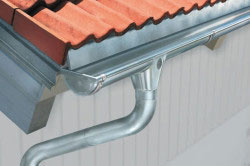
Metal drainage is widely popular due to the combination of aesthetics, strength and fire safety.
One of the most inexpensive options is galvanized steel. The main minus of such a material is low corrosion resistance. In combination with plastic coatings (Pural, Plastisol), you can not only extend the life, but also give the drainage system an additional decoration on the roof.
The drain copper system is most durable, but also has more expensive cost. When using patina as a coverage, the operation is not only increased, but also an exquisite is given in appearance. Most often, the waterproofs from copper are combined with tiled roofs. The complicated option is the installation of a radius gutter describing the facade of the building (soldering or welded).
The drains made from the zinc-titanium alloy have a surface of a single patina-alkali zinc carbonate formed.
The operational term of such waterproofs is more than a century if there is no contact with the copper or iron element.
Plastic plums
Plums from plastic for roofs have quite affordable cost and a successful combination of long-term operation with convenience when installing. The set of plastic drainage includes:
- chute;
- pipes;
- funnels;
- couplings;
- fastening, angular, connecting elements;
- pipes.
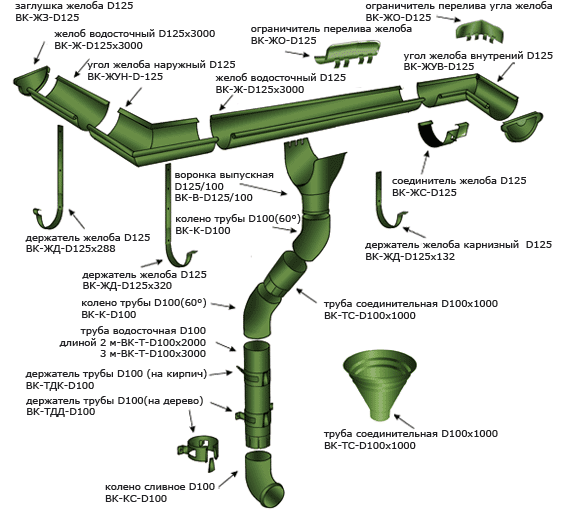
Device drain
In order to make the roof drain, there are several ways.
It is possible to use the walls and scat to tightly, if you use a drain, which has a double backstage. On the roof, the slope of which is more than 300 degrees, it is necessary for the device for additional systems from covering tips and corners.
The width of those parts that are placed on the tile should be at least 10 cm, and vertical - more than 7.5 cm. Drain corners must be attached when laying slate tiles or tiles. Vertical parts of the corners must be pressed against the wall. From above it overlaps a step drain. The top edges of the corners are bend and lay in masonry seams. Then they are fixed using wedges and are expanded with cement mortar.
Make metal plums on the roof, where the coating is the profiled tile, it is possible with a single adhesive one. In such cases, on the roof, the metal sheet is inserted with one edge into the masonry seam, and the second is lowered and starts over the next side of the ridge.
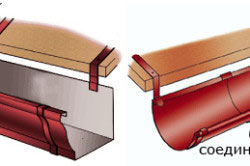
Rectangular and round sections of drainage.
There are systems with two types of sections: rectangular and round.
With an independent drainage device for removing rainwater, it should be borne in mind that the rectangular cross section of the drainage is more complex during installation, but allows the construction of a modern and attractive appearance.
For any kind of roofing, there is an opportunity to choose a suitable color scheme. Installing a square profile is recommended in areas where a large amount of precipitation falls. In such situations, the device helps to ensure better water removal.
The elements included in the PVC drain package can be mounted with a glue or with a rigid clutch, which protrude rubberized components.
Adhesive connections are considered the most reliable and easier to install them.
Rubber can also come into disrepair and losing quality properties. A different garbage can be clogged in the compound, which will create obstacles to the normal operation of drainage systems.
Plastic plums have stiffeners that attach strength to the system. But, if you do not comply with the rules, all these advantages of the design are reduced to zero.
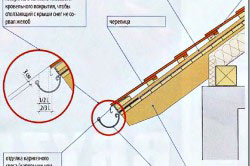
Intelligent features of the installation of plums.
Requirements for installation:
- the gap between the fasteners should be not more than 60 cm;
- the roof must be serviced by one drain pipe, the area of \u200b\u200bwhich does not exceed 100 m 2;
- the total must be 0.5 cm for each m pens;
- if you need to install connectors, funnels, the corners of the nearbone is located at a distance of no more than 5 cm;
- in order to avoid the leakage of rainwater on the roof, the external side of the pipe should have 0.5 cm of the slope.
Cement drain systems for roofs have a number of advantages: reliable operation, simplicity when installing and relatively low cost. Significant disadvantage - shrinkage. To date, such systems are used very rarely. Often they are found in the pitched roofs of old buildings.
Regular cleaning of the drainage pipe
The maintenance of the drainage systems is provided not only by the correct selection of high-quality elements of the structure and competent installation, but also regular cleaning of roofing plums. This is especially true of autumn cleaning.
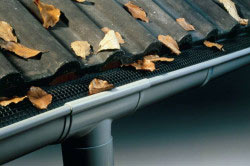
Additionally, a grid is installed, which accumulates the garbage.
Modern drainage systems do not require special care measures. They do not need painting or the use of other anti-corrosion products. But it is necessary to comply with the correct transportation, installation and cleaning of surfaces in order to avoid the appearance of small scratches.
To prevent getage in the gutter and pipes together with rainwater of various garbage, the installation of special grids is recommended. If the prevention was not effective enough, then make the removal of garbage can be a strong jet of water from the hose for watering.
You can also perform drainage where there is a built-in icing system, which includes cables, temperature and humidity sensors.
Technical novelty, which is used in the maintenance of drainage systems is the installation of robotic devices. They carry out safe and efficient pipe cleaning. This unit includes an intelligent recognition system, which is capable of evaluating the nature and degree of contamination, determining the required number of passes, calculating the intensity of purification. All work on cleaning it is capable of doing independently. Such a system is very suitable for those who do not have time to mess around with the drain.

